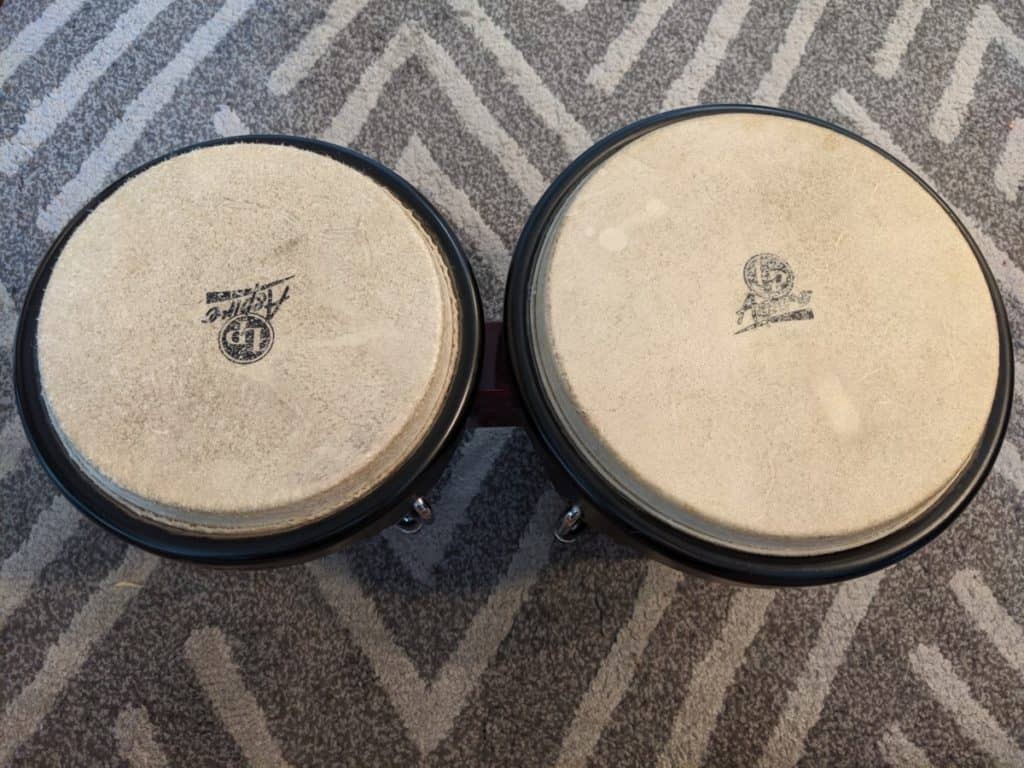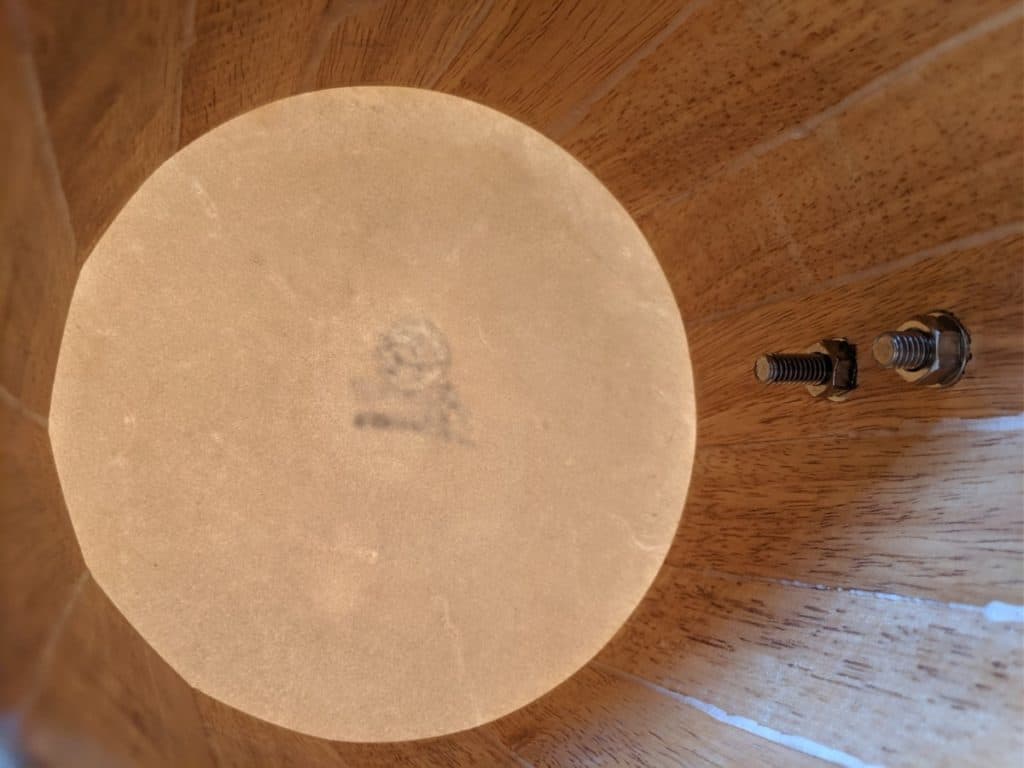This post contains affiliate links. We earn commissions if you purchase products from retailers after clicking on a link from our site. As an Amazon Associate, we earn from qualifying purchases.
We know how to play bongo drums–we hit the drum with our fingers and we get that satisfying *pop* or *thud* depending on how we strike the drum. But how does a bongo drum work? Why does a bongo drum sound the way it does? And why does a bongo drum ring when you hit it on the edge?

By the way, looking for recording equipment and musical instruments? Check out Sweetwater.com for microphones, monitors, audio interface or any other recording gear that you could ever need. (Affiliate Link)
Bongo drums make their distinctive sound by striking the drumhead with your hands and fingers. The sounds from the bongo drum come from the vibrating drumhead, which vibrates the surrounding air, which is the source of sound. The distinctive ring of a bongo drum comes from the resonance of the bongo drum shell.
Seems simple right? But let’s dive in and try and understand what’s going on so when our kids ask us we know what we’re talking about, and we don’t have to make up wild stories about drum gnomes or something like that.
What Do Bongos Sound Like?
Before we start talking about how bongos make sound, here are is a sample of what bongos sound like:
Check out my page if you want to hear dozens of samples of different sounds the bongos can make.
How Do Bongo Drums Make Sound?
The construction of the drum has the key to how bongo drums make their sound. Let’s talk about the specifics.
Bongo drums have a distinct construction: two separate drums of two sizes put together, the larger drum being called the Hembra, and the smaller drum being called the Macho.
Bongo drums are open on one side as opposed to some drums (like a typical snare drum, for example) which have drumheads on both sides of the drum.
The drumhead of the bongo drum is traditionally made from animal skins (learn more about what kinds of animal skins are used at our article here), but commonly, these days, they are made from synthetic material (often made to look like animal skin).
So, that’s what bongo drums look like, how are they played?
A bongo drum, like any drum, makes its sound by being struck. That’s right, you hit it! Bongo drums are typically meant to be played with your hands, although some choose to play bongos with sticks. You can achieve a much more dynamic sound with your hands because hands are more dynamic than drumsticks!
A Super Brief Summary of How Sound Works
Now that we know what bongo drums look like and how they are played, one fundamental thing to understand before understanding how bongos make sound is that we perceive sound by vibrated air.
When a person talks, or the dishes clatter, or an alarm buzzes, the action vibrates the air which travels to our ears. In fact, our ear has a drum of its own! Our ear drum is a tight membrane which receives the vibrating air and translates it into what our brain perceives as sound.
The slower the vibration, the lower the sound is. Think of the the dull thud of a car door closing.
The faster the vibration, the higher the sound is. Think of the high-pitched sound of a mosquito next to your ear (a sound which always manages to unnerve me).
Bongo Drum Vibrations
Bongo drumheads are like any other drumhead in principle: a tight membrane stretched over a shell.

When you strike the drum, the membrane vibrates (looking somewhat similar to when you drop a pebble in a puddle), which in turn causes the air within the bongo drum to vibrate.

The tighter the drumhead, the faster the vibrations happen, meaning a higher drum sound (also called pitch).
The looser the drumhead, the slower the vibrations happen, meaning a lower pitch.
What Causes the Bongo Drum to Ring?
If you play bongo drums, you may have noticed that sometimes the drums “ring”, especially if you hit the bongo drum on the edge of the drumhead (called the bearing edge).
This ringing is likely due to resonance. Resonance is when something vibrates which causes another object to vibrate. Many objects have a natural resonant frequency, which is a frequency that they will vibrate most intensely at.
I don’t know if you’ve experienced this, but if you’re in a metal enclosure without any cushion, such as in a stall of some sort, or if you’re in a very small room with reflective hard surfaces, if you hum through a scale, you might find a frequency that you can feel the entire room or enclosure start to hum along with you. It’s a crazy feeling, and I’ve found it at odd times, but this is when your humming has found the natural resonant frequency of that object.
The drumhead and the drum shell have their own frequencies that they resonate at. If you hit the drums along the edge at just the right power, you’ll be able to hear that resonance very clearly.
Interesting tidbit: You might not have known that many bongo players try to avoid the ringing sound, and prefer their bongo drum to sound dry, which is a fancy sound term that in this case just means a bongo drum with little if any ringing.
To counter this, you can avoid striking near the bearing edge and hit closer to the center of the bongo drum. Furthermore, drummers will put a gentle adhesive on the underside of their drumhead to muffle the drum and prevent this resonance.
What Affects the Sound of the Bongo Drum?
Believe it or not, almost every aspect of the bongo drum affects the way it sounds.
- The size of the drums: As we’ll discuss in the next section, the size of the drum can impact its sound.
- The material of the outer shell: There are dozens of different types of wood, and hundreds of way to cut it and process it. This gives you thousands of possibilities as far as the sound of a drum since they all will react differently. Metal drums have a different sound all on their own.
- The hardware attached to the bongo drum: Some consider the nuts and bolts that attach the drums together to be a detriment to the tonal quality of the drums–some bongo drums are in fact not connected by hardware but via other methods.
- The drum shape: The shape of the drum will change how the drum will resonate.
- How the drums are held: Since drums work by vibrating the air around them, if you cover up the the bottom of the drums (such as if you set the bongo drums on your lap), then you will create a more muffled sound. The traditional way to hold bongos exposes the bottom of the bongo drums by holding the drums between your legs, so your legs are gripping the drums from the sides. This posture creates a much more open and full sound.
- The thickness of the drumhead: Thick drumheads will have a richer sound and will sound lower than another thinner drumhead of the same tightness.
- The drumhead material: Is the bongo drumhead synthetic? Or made from animal skin? Is the drumhead from a goat? Or a cow? The material for your drumhead can drastically affect the sound. Synthetic drumheads don’t have the same richness of sound, but are bright and they pop, and are uniform. Animal skins can vary widely in the feel and texture of the skin.
- Drumhead tightness: Most bongos are tunable. You can use a wrench to tighten or loosen the lug nuts that are pulling the skin across the bearing edge of the bongos. The skin tightness heavily affects the sound of a bongo drum. A well-tuned bongo drum gives a lively pop rather than a dull, lifeless thud. It’s mostly up to the bongo player to what sound they want to go for.

Why Does the Bigger Hembra Drum Sound Lower Than the Smaller Macho Drum?
In practice, the macho can sound lower than the hembra, if the macho drumhead is loose enough, and the hembra is tight enough.
If, however, the macho is as tight as the the hembra skin, the hembra skin will sound lower. Why?
Doing research for this made me realize that this is more complicated than it may seem, and that there are multiple reasons why this is.
First, since the hembra (the bigger drum) has a larger diameter drumhead, a vibration applied to the drumhead surface (such as from your finger) takes longer to travel across the drumhead, which means the the vibration of the drumhead is at a lower frequency, which means the bigger drums will sound at a lower pitch.
The second factor is the resonance of the drum shell itself. Smaller objects have higher natural resonance frequencies, while larger objects tend to have lower natural resonance frequencies. This makes sense: A smaller voice box will sound higher, and a larger voice box will sound lower. A trombone sounds lower than a trumpet because a trombone has more metal.
Thus, the smaller macho drum has a higher resonance frequency than the bigger hembra drum.
Conclusion
Hope that helps! Now you’ll be able to appreciate the beautiful sound of your bongo drum a bit more fully than you did before.
